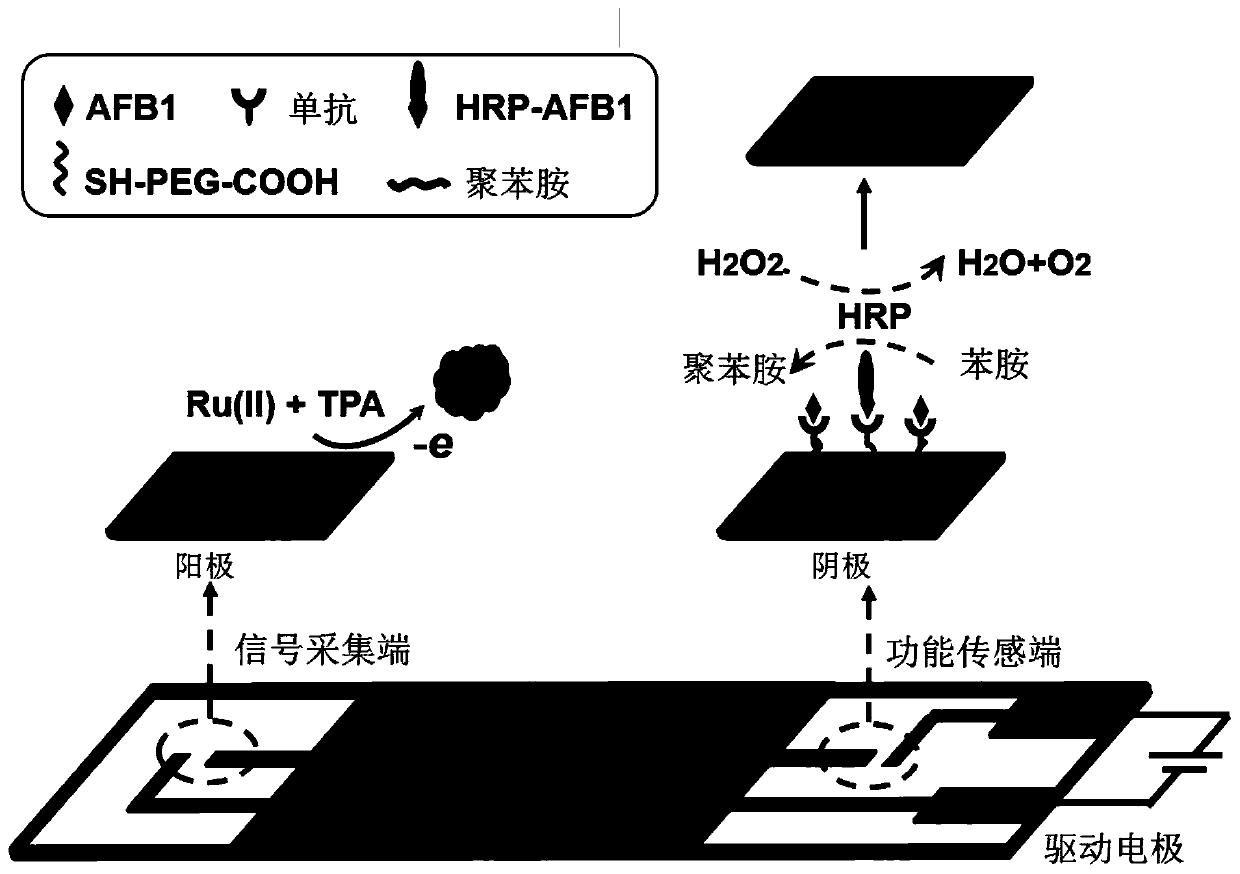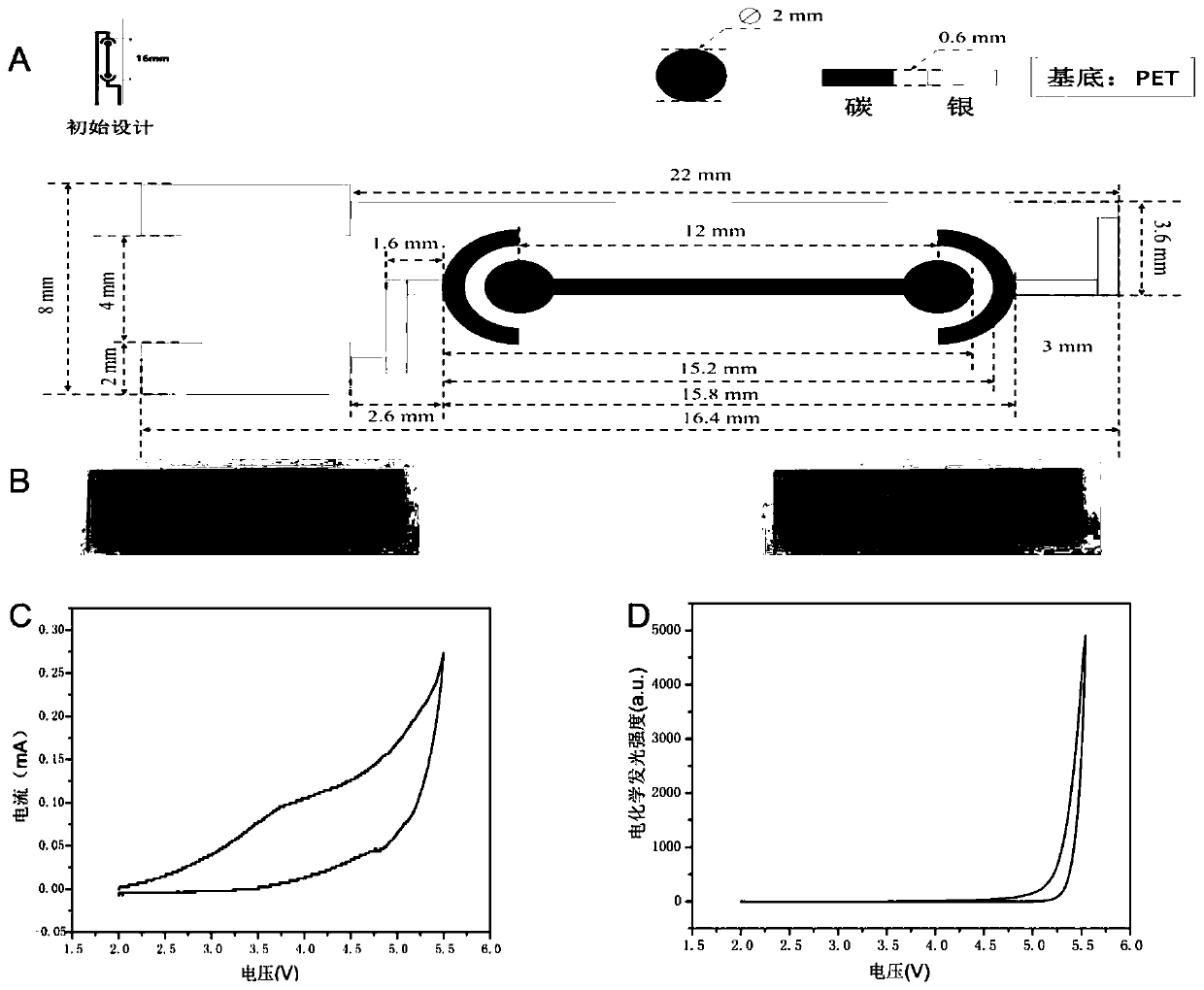Method for detecting aflatoxin B1 based on visual BPE-ECL technology
A technology for aflatoxin and technical detection, applied in the field of detection of aflatoxin B1 based on visual BPE-ECL technology, can solve the problems of high risk, inaccurate quantification, complicated operation process, etc., and achieve highly sensitive ECL detection and realization Effects of ECL detection and easy arraying
- Summary
- Abstract
- Description
- Claims
- Application Information
AI Technical Summary
Problems solved by technology
Method used
Image
Examples
Embodiment 1
[0037] The method for detecting AFB1 in agricultural products based on visual BPE-ECL technology, the detection steps are:
[0038] 1. Preparation of screen-printed bipolar electrodes: firstly, polyethylene terephthalate (PET) is selected as a cheap electrically inert material as the substrate, and then two working electrode leads are printed with silver ink at both ends of the substrate; then Dry the substrate, print the carbon electrode with carbon paste in the middle of the two working electrodes and dry it to obtain the anode and cathode of the bipolar electrode; then print with photo-curable insulating paste (UV curable insulating ink, etc. The electrode standard layer is cured with ultraviolet light; finally, the electrode insulating layer is printed with light-curable insulating paste and cured with ultraviolet light. The overall length of the screen-printed electrode is about 3 cm, the width is about 1 cm, and the length of the bipolar electrode wire is about 12 mm. A...
Embodiment 2
[0045] The establishment of embodiment 2 standard curve--determination of detection limit and detection range
[0046] Take 10 μL of different concentrations (0, 0.1, 0.5, 1, 5, 10, 20, 50, 100 ng mL -1 ) of AFB1 standard with 10 μL of 100ng mL -1 HRP-AFB1 was mixed and reacted with the monoclonal antibody on the functional sensing interface constructed in Example 1. After airtight incubation at room temperature for 2 hours, after washing with PBS, 20 μL of 0.1M acetic acid / sodium acetate buffer solution (200 mM aniline, 20 mM Hydrogen peroxide, 0.5 μM DNA, pH 4.3), incubate at room temperature for 2 h in the dark. Do not wash, and add 20 μL co-reactant (10mM Ru(bpy) 3 (Cl) 2 ·6H 2 (0, 50 mM TPA), and the bipolar electrode was connected to an electrochemiluminescence analyzer (ECL) with a connector for measurement. Experimental results such as Figure 6 As shown, when the concentration of AFB1 is 0.1-100ng mL -1 Between, the intensity of electrochemiluminescence has a g...
Embodiment 3
[0047] Embodiment 3 specific detection
[0048] Take 7 EP tubes and add HRP-AFB1 and different mycotoxin solutions to each tube to obtain a final concentration of 100ng mL -1 HRP-AFB1 antigen and 100ng mL -1 Mycotoxins, 7 tubes of 100ng mL each -1 HRP-AFB1 antigen and 10ngmL -1 BSA-AFB1, 100ng mL -1 HRP-AFB1 antigen and 10ng mL -1 Aflatoxin M1 (AFM1), 100ng mL -1 HRP-AFB1 antigen and 100ng mL -1 Zearalenone (ZEN), 100ng mL -1 HRP-AFB1 antigen and 100ng mL -1 Ochratoxin A (OTA), 100ng mL -1 HRP-AFB1 antigen and 100 ng mL -1 Deoxynivalenol (DON), 100ng mL -1 HRP-AFB1 antigen and 100ng mL -1 Patulin, 20 μL was added to the functional sensing interface (the cathode end of the bipolar electrode) constructed in Example 1, and after the competition reaction was carried out for 2 hours, after washing with PBS, 20 μL, 0.1M acetic acid / Sodium acetate buffer solution (200 mM aniline, 20 mM hydrogen peroxide, 0.5 μM DNA, pH 4.3), incubated at room temperature for 2 h in the ...
PUM
 Login to View More
Login to View More Abstract
Description
Claims
Application Information
 Login to View More
Login to View More - R&D
- Intellectual Property
- Life Sciences
- Materials
- Tech Scout
- Unparalleled Data Quality
- Higher Quality Content
- 60% Fewer Hallucinations
Browse by: Latest US Patents, China's latest patents, Technical Efficacy Thesaurus, Application Domain, Technology Topic, Popular Technical Reports.
© 2025 PatSnap. All rights reserved.Legal|Privacy policy|Modern Slavery Act Transparency Statement|Sitemap|About US| Contact US: help@patsnap.com



